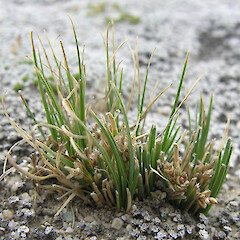Carex decurtata
Common name
sedge
Synonyms
Carex cryptocarpa Cheeseman
Family
Cyperaceae
Flora category
Vascular – Native
Endemic taxon
Yes
Endemic genus
No
Endemic family
No
Structural class
Sedges
NVS code
The National Vegetation Survey (NVS) Databank is a physical archive and electronic databank containing records of over 94,000 vegetation survey plots - including data from over 19,000 permanent plots. NVS maintains a standard set of species code abbreviations that correspond to standard scientific plant names from the Ngä Tipu o Aotearoa - New Zealand Plants database.
CARDEC
Current conservation status
The conservation status of all known New Zealand vascular plant taxa at the rank of species and below were reassessed in 2017 using the New Zealand Threat Classification System (NZTCS) – more information about this can be found on the NZTCS website. This report includes a statistical summary and brief notes on changes since 2012 and replaces all previous NZTCS lists for vascular plants.
Please note, threat classifications are often suggested by authors when publications fall between NZTCS assessment periods – an interim threat classification status has not been assessed by the NZTCS panel.
- Conservation status of New Zealand indigenous vascular plants, 2017 . 2018. Peter J. de Lange, Jeremy R. Rolfe, John W. Barkla, Shannel P. Courtney, Paul D. Champion, Leon R. Perrie, Sarah M. Beadel, Kerry A. Ford, Ilse Breitwieser, Ines Schönberger, Rowan Hindmarsh-Walls, Peter B. Heenan and Kate Ladley. Department of Conservation. Source: NZTCS and licensed by DOC for reuse under the Creative Commons Attribution 4.0 International licence.
2017 | Data Deficient | Qualifiers: Sp
Previous conservation statuses
2012 | Data Deficient | Qualifiers: Sp
2009 | At Risk – Naturally Uncommon
2004 | Range Restricted
Distribution
Endemic. South Island from Canterbury to Otago, mainly known from the Mackenzie Basin (particularly from Lakes Tekapō, Pukaki and nearby tarns).
Habitat
A plant of lake, tarn margins, and river sides, preferring open stony ground or situations with little surrounding vegetation. Tolerant of long periods of water immersion.
Wetland plant indicator status rating
Information derived from the revised national wetland plant list prepared to assist councils in delineating and monitoring wetlands (Clarkson et al., 2021 Manaaki Whenua – Landcare Research Contract Report LC3975 for Hawke’s Bay Regional Council). The national plant list categorises plants by the extent to which they are found in wetlands and not ‘drylands’. The indicator status ratings are OBL (obligate wetland), FACW (facultative wetland), FAC (facultative), FACU (facultative upland), and UPL (obligate upland). If you have suggestions for the Wetland Indicator Status Rating, please contact: [Enable JavaScript to view protected content]
FACW: Facultative Wetland
Usually is a hydrophyte but occasionally found in uplands (non-wetlands).
Detailed description
Densely tufted bright green, bronze green to yellow-green, diminutive sedge of river terraces, lake and wetland margins. Culms 20–70 mm long, enclosed by light to dark brown leaf-sheaths almost to their apex. Leaves much longer than culms, 30–90 × 0.5–1 mm, almost flat bright green, bronze green to yellow-green, concavo-convex, almost flat, linear, rather rigid and coriaceous, margins scabrid, gradually tapering to a subacute apex, incurved when dry; sheaths twice as broad as lamina, pale brown with chartaceous to membranous margins. Inflorescence a crowded head of 3–5 spikes. Spikes: terminal spike male; lower spikes female, 4–8 mm long, ovoid or oblong-ovoid, greenish-brown, sessile or the lowermost rather shortly pedunculate; spikes subtended by leaf-like bracts which are longer than the inflorescence. Glumes ≤ utricles, ovate to orbicular, acute or with the midrib extended into a long scabrid awn, nerved, membranous, red-brown with a pale centre and margin, or pale straw-coloured. Utricles 2.5–3 × 1.5 mm, plano-convex to subtrigonous, broadly ovoid, light brown, turgid at the back, faintly nerved, spreading, margins thickened and serrated toward apex, beak 0.5 mm long, scabrid, crura acutely cleft, scabrid; stipe absent although utricle narrows towards base (a pseudostipe). Stigmas 3. Nut 2 mm long, grey-brown, trigonous.
Similar taxa
Close to C. hectorii Petrie from which it differs by the light brown rather than dark brown utricles, densely tufted rather than spreading shortly rhizomatous habit, and bright green, bronze-green to yellow-green, rather than blue-green to red-green leaves.
Flowering
October–January
Fruiting
October–July
Life cycle
Nuts surrounded by inflated utricles are dispersed by granivory and wind (Thorsen et al., 2009).
Propagation technique
Easily grown by division of whole plants and fresh seed. Somewhat fickle in dry or humid climates and does best in a small pot.
Threats
A naturally uncommon species largely confined to the intermontane basins of Canterbury and Otago. In some places it is now at risk from canalisation, dairy farming (irrigation mainly) and the resultant influx of exotic weed species. Its conservation status may require reassessment.
Etymology
carex: Latin name for a species of sedge, now applied to the whole group.
Where To Buy
Not commercially available.
Attribution
Description adapted from Moore and Edgar (1970)
References and further reading
Moore LB, Edgar E. 1970. Flora of New Zealand, Volume II. Indigenous Tracheophyta: Monocotyledones except Gramineae. Government Printer, Wellington, NZ. 354 p.
Thorsen MJ, Dickinson KJM, Seddon PJ. 2009. Seed dispersal systems in the New Zealand flora. Perspectives in Plant Ecology, Evolution and Systematics 11: 285–309.










